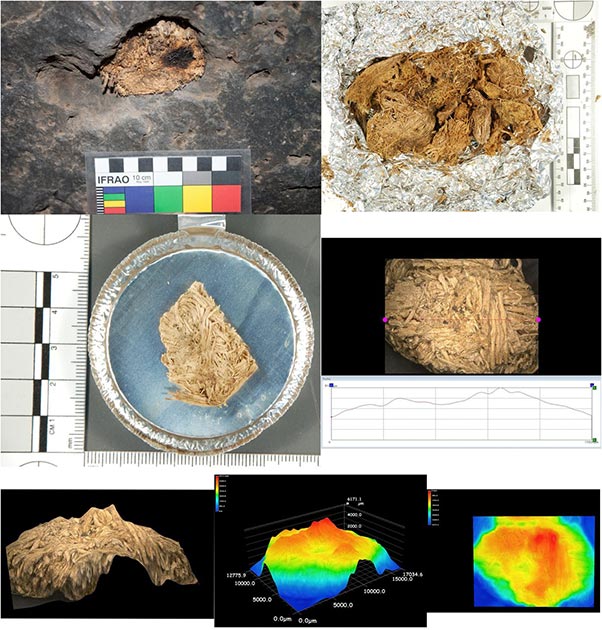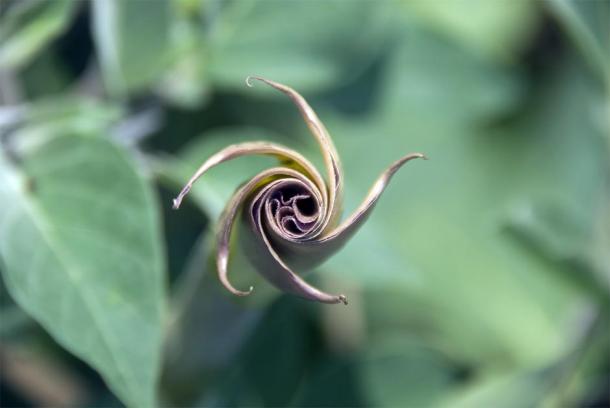When you think of psychedelics and the United States, famous psychonauts like Timothy Leary, Gerry Garcia and Jim Morrison come to mind. In the 1991 movie, The Doors , Jim Morrison got seriously stoned and wandered out into the New Mexico desert experiencing the full optical range of nature. But a new study suggests he was only one explorer in a long and ancient line of North American trippers .
Datura – a Broadband Connection with the Gods
Geometric symbols including zigzags and spirals appears on ancient rock art across the planet and it has long been suspected that the artisans were expressing visions experienced under the influence of psychoactive compounds. Now, in Pinwheel Cave, about 80 kilometers (49.7 miles) northeast of Santa Barbara in Southern California , 500-year-old cave art suggests Native American cultures did indeed consume psychoactive compounds, but that the art itself is perhaps “not´ what we might think.
The name of the site, “Pinwheel Cave,” is named after large, red, pinwheel-shaped drawing on its ceiling. Over the years archaeologists have speculated that this design represents the psychoactive Datura flower. Loaded with mind altering entheogens, like the alkaloids scopolamine and atropine, datura was used across the ancient world in ritual settings to commune with the spirits , for example, in Indian traditions the God Shiva “Was in love with datura seeds.” You can watch my YouTube video explaining the datura plant’s chemical compounds, and its spiritual, medical and criminal applications here.

Archaeologist doing laser scanning inside the Pinwheel Cave in California. ( Robinson et. al / PNAS )
Flying Gum of the Gods
The Chumash people of Southern California are a Native American group who historically inhabited the central and southern coastal regions of California. Professor David W. Robinson from the School of Forensic and Applied Sciences at the University of Central Lancashire, United Kingdom, has published a new paper in the Proceedings of the National Academy of Sciences discussing Chumash Datura ceremonies and the resulting “sacred dreams.”
In 2007 excavators recovered arrowheads, tools, and food scraps at the Pinwheel Cave, and also chewed remnants of quids (plant materials) that were pushed into cracks in the cave ceiling. Now, new chemical analyses and electron microscopy has confirmed these ancient mixtures contain datura. Dr. Robinson says this is the “smoking gun of hallucinogens at a rock art site.” However, Paul Bahn, an archaeologist at Archaeological Institute of America, said the team have distanced from the “ludicrous school of thought,” which saw all rock art as trance imagery produced by shamans.

Archaeologists recovered artifacts including arrowheads, tools, and food scraps at the Pinwheel Cave, alongside chewed remnants of quids (plant materials) in the cracks of the cave ceiling. Analysis of these quids confirmed they contain sacred datura. ( Robinson et. al / PNAS )
Venerating the Super Plant
Challenging traditional ideas of reclusive shamans going on hallucinogenic trips isolated in nature, like Jimmy Morrison, and painting their visions and insights, this new study argues the art “may not be a depiction of the user’s experience of the Datura.” The researchers suggest that the large red wheel might have been a powerful message to the community regarding “the plant’s importance,” and not from the experience it catalyzes. Robinson explains that the red wheel painting might represent “the actual plant itself,” rather than a vision experienced by any one person under the influence of the plant´s entheogens.
This article will all add up for those readers who haven’t had a psychedelic experience, but it will make “utter and absolute sense” for those who have. What I mean by this is that history is written in the most part by sober scientists, amongst which one could speculate only a tiny percentage have ever tripped. But those who have experienced these other aspects to reality, thanks to consumption of an entheogen, understand clearly is that there is no conceivable way to start and finish anything while tripping, never mind designing and fulfilling an intricate geometric design .

An unfurling Datura Wrightii, known as a sacred datura, a species which has been used as a hallucinogen throughout history. ( HVPM dev / Adobe Stock)
Tied in Knots on Datura
You might indeed “see” and “think” of such a symbol when on datura, and it might momentarily seem like it is deeply symbolic of the mechanics of cosmic creation, but while on these compounds you will struggle to tie your own shoelaces. What the paper suggests is that while the image might have been inspired during a hallucinogenic trip, it is unlikely that it was executed at the same time. Thus, the plant itself might have been deemed more sacred than its otherworldly insights.
Top image: New study analyses rock art at the Pinwheel Cave in California, seen here next to an unfurling sacred datura plant. Was it created under the influence? Or, is there another explanation? Source: Robinson et. al / PNAS
By Ashley Cowie
Related posts:
Views: 0
 RSS Feed
RSS Feed

















 November 25th, 2020
November 25th, 2020  Awake Goy
Awake Goy 





 Posted in
Posted in  Tags:
Tags: 
















